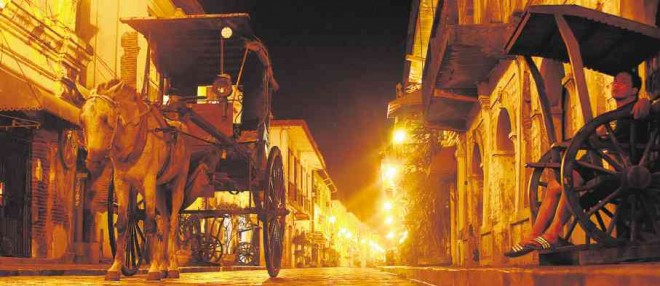
THE OLD WORLD charm of Vigan is a major factor that pushed this little city in Ilocos Sur to the list of New Seven Wonders Cities of the world. LEONCIO BALBIN JR. / CONTRIBUTOR
Texting has propelled many Filipinos to become beauty queens and singing champions. Last year, because of texting, a “quaint, little city,” as one writer described Vigan in Ilocos Sur, became at par with the fabled cities of Havana and Beirut, when it was named one of the New Seven Wonders Cities of the world.
More than 1,200 cities in over 200 countries tried to get into the scene and for Vigan, the hardest battle was when it had to fight it out with the cities of Bacolod, Cagayan de Oro, Cebu, Davao, Iloilo and Parañaque, as only one city from each country can make it to the list.
The other six Philippine cities launched their own campaigns on social media and other venues where their residents can vote. These cities are far more populated than Vigan.
But then Vigan is not known as a “small city with big dreams” for nothing.
“To us coming from such a small city, this seemed farfetched. Yet, we dared to dream big together, working hand-in-hand to make it a reality and now, Vigan, we are living the dream,” Mayor Eva Marie Singson Medina said.
Going back in time
For Medina, the strategy was to go back in time. She said that two decades ago, Vigan was a sleepy, economically deprived town moving on a slow pace. But these qualities would catapult it to world fame.
Vigan, or part of it, was the third oldest city in the Philippines, after Manila and Cebu. In 1572, Spanish conquistador Juan de Salcedo came to Vigan and founded “Villa Fernandina de Vigan” in honor of King Philip II’s son.
Vestiges of this Old World mixed with Malay and Chinese influences are still evident in the city center. Medina would later use Quezon Avenue as the demarcation line of development with all buildings on the left having to conform with the Vigan architecture.
The city also campaigned for and was included in the United Nations Educational, Scientific and Cultural Organization’s World Heritage List in December 1999.
Cultural management
In getting the Wonder City nod, Vigan also strengthened its cultural management.
“We hope that this feat will send a stronger message that heritage conservation, interwoven with good governance and community participation, is a very significant tool for development,” Medina said.
The city also established the Escuela Talyer (School for Traditional Building Crafts) to train a pool of craftsmen to maintain, repair or restore its buildings. Last year, Unesco
also came out with the Vigan Heritage Homeowners’ Preservation Manual.
Last week, the Vigan Conservation Complex was inaugurated. The 3-hectare complex in Barangay (village) San Julian Sur is composed of four postmodern buildings, which houses three museums, a repository and a conservation school.
The three museums, built and conceptualized by Prof. Eric Zerrudo of the University of Santo Tomas’ Center for Conservation of Cultural Property and Environment in the Tropics, revolve around the concepts of Pammati ken Kari (Devotion and Power), Casa Bigueño (the Evolution of the Vigan House) and Ciudad Lungsod (Outlining the City).
In the repository are posts, stairs, windows and other parts of houses that were bought from owners of demolished houses. These materials are to be resold to Bigueños who want to restore their old houses.